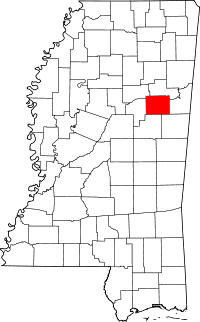Mississippi State University
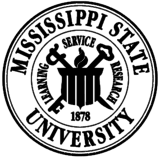 | |
| Motto | Learning, Service, Research |
|---|---|
| Type |
Public University Land-Grant Sea-Grant Space-Grant |
| Established | 1878 |
| Endowment | US$456,609,736 (2014)[1] |
| President | Mark E. Keenum |
Academic staff | 1,359[2] |
Administrative staff | 3,361 |
| Students | 21,622 systemwide[3] |
| Location |
Mississippi State, Starkville, Mississippi, U.S. 33°27′14″N 88°47′20″W / 33.454°N 88.789°WCoordinates: 33°27′14″N 88°47′20″W / 33.454°N 88.789°W |
| Campus | Rural 4200 acres[4] |
| Colors | Maroon and White [5] |
| Athletics | NCAA Division I – SEC |
| Nickname | Bulldogs |
| Mascot | Bully |
| Affiliations | APLU |
| Website | msstate.edu |
 | |
The Mississippi State University of Agriculture and Applied Science,[6] commonly known as Mississippi State University (MSU), is a land-grant university located in Oktibbeha County, Mississippi, United States, partially in the town of Starkville and mostly in an unincorporated area.[7][8] Mississippi State, Mississippi is the official designation for the area that encompasses the university.
It is classified as a "comprehensive doctoral research university with very high research activity" by the Carnegie Foundation.[9] The university has campuses in Starkville (main), Meridian, Biloxi, and Vicksburg, Mississippi.
History
The university began as The Agricultural and Mechanical College of the State of Mississippi (or Mississippi A&M), one of the national land-grant colleges established after Congress passed the Morrill Act in 1862. It was created by the Mississippi Legislature on February 28, 1878, to fulfill the mission of offering training in "agriculture, horticulture and the mechanical arts . . . without excluding other scientific and classical studies, including military tactics." The university received its first students in the fall of 1880 in the presidency of General Stephen D. Lee.
In 1887 Congress passed the Hatch Act, which provided for the establishment of the Agricultural Experiment Station in 1888. The Cooperative Extension Service was established in 1914 by the Smith-Lever Act. The university has since had its mission expanded and redefined by the Legislature. In 1932, the Legislature renamed the university as Mississippi State College.
In 1958 the Legislature renamed the university as Mississippi State University in recognition of its academic development and addition of graduate programs. The Graduate School had been organized (1936), doctoral degree programs had begun (1951), the School of Forest Resources had been established (1954), and the College of Arts and Sciences had replaced the General Science School (1956).
The university was uneventfully desegregated in July 1965, when Richard E. Holmes of Starkville became the first African-American student to enroll. The Civil Rights Act of 1964 was passed by Congress the year before, the Voting Rights Act of 1965 was being debated, and the United States Supreme Court had ruled in Brown v. Board of Education (1954) that segregation of public schools was unconstitutional.[10]
The School of Architecture admitted its first students in 1973, the College of Veterinary Medicine admitted its first class in 1977. The MSU Vet school (commonly referred to as the CVM) is the largest veterinary school under one roof in the nation. The School of Accountancy was established in 1979.
The University Honors Program was founded in 1968 in order to provide more rigorous course curricula for academically talented students, as well as to support guest lecture series, forums, and distinguished external scholarships. The program has been vastly expanded and has a separate college. This was made possible by funding by Bobby Shackouls, an MSU alumnus and retired CEO, who donated US$10 million to found the Judy and Bobby Shackouls Honors College in April 2006.[11]
MSU also started a joint Ph.D. program in engineering with San Jose State University in California, allowing an increase in research for both universities, as well as enhancing the stature of both engineering colleges.[12]
In March 2009, Mississippi State announced the conclusion of the university's seven-year capital campaign, with more than $462 million received in private gifts and pledges.[13]

Campuses
Mississippi State University is accredited by the Commission on Colleges of the Southern Association of Colleges and Schools to award baccalaureate, master's, specialist, and doctoral degrees.
Today, the university has the following colleges and schools:
|
|
As of Fall 2011, the current total enrollment of Mississippi State is 20,424.[14] The university contains 160 buildings, and the grounds of the university comprise about 4,200 acres (17 km²), including farms, pastures, and woodlands of the Experiment Station. The university also owns an additional 80,000 acres (320 km²) across the state.
Mississippi State University also operates an off-campus, degree-granting center in Meridian where both undergraduate and graduate programs are offered. In cooperation with the U.S. Army Engineer Waterways Experiment Station, the College of Engineering offers the Master of Science degree to students in Vicksburg.
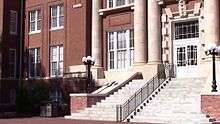
Mississippi State's campus is centered on the main quadrangle, called the Drill Field (pictured) due to its heavy use by the Corps of Cadets prior to the end of World War II. The Drill Field is defined at its north and south ends by the mirror-image buildings, Lee Hall (the original University building, now the division of languages building, far left in picture below) and Swalm Hall (home to the Dave C. Swalm School of Chemical Engineering, far right in picture below). Old Main was the original dormitory, west of Lee Hall; it burned in a tragic fire, and was replaced by the Colvard Student Union. The largest building fronting the Drill Field is Mitchell Memorial Library.

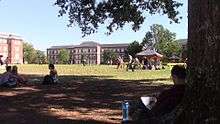
From the Drill Field, the campus radiates in all directions. The College of Engineering can be found mostly to the east side of the Drill Field; to the north are the Arts and Sciences, including Computer Science, and the College of Architecture, Art, and Design (CAAD). Humanities are found to the south, while Agriculture dominates the west section. To the west and northwest are also found the athletic facilities, including Scott Field and the Humphrey Coliseum, or The Hump.
Beyond the main campus (and the series of commuter parking lots ringing the main campus) are the North and South Farms. While still used for their original purpose of agricultural research, the Farms are also host to newer facilities, such as the astronomical observatory and Veterinary College (South Farm) and the High Performance Computing Collaboratory (North Farm). At the far west of campus, one finds first the fraternity and sorority houses, and beyond them the Cotton District and downtown Starkville, Mississippi. The university is also home to the Thad Cochran Research, Technology and Economic Development Park, which host many of the university's research centers, such as the Center for Advanced Vehicular Systems (CAVS) and the nationally-recognized Social Science Research Center.
Mitchell Memorial Library
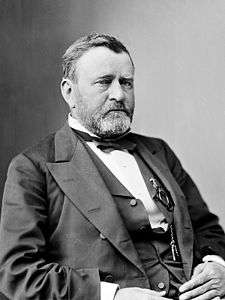
The Mitchell Memorial Library is located in the heart of the campus, on the eastern side of the Drill Field. [15] The library has a collection of 2,124,341 volumes and 70,331 Journals.[16]
Mississippi State is one of the few universities to house presidential papers. In May 2012, on the 50th anniversary of the founding of the Ulysses S. Grant Association, Mississippi State University was selected as the permanent location for Ulysses S. Grant's Presidential Library. President Grant's artifacts are to remain permanently at the Mitchell Memorial Library on the MSU campus. These include Grant's letters and photographs during his presidency, from 1869 to 1877. The MSU library catalogued and cross-referenced 15,000 linear feet of material. Grant's letters have been edited and published in 32 volumes by the Ulysses S. Grant Association and the Southern Illinois University Press.[17][18]
The Library is also home to The Congressional and Political Research Center, which is located on the first floor. This Center, established in November 1999, houses the collections of US Senator John C. Stennis and Congressman G. V. Montgomery, nicknamed "Sonny." Their careers spanned a total of 72 years of service as Congressional leaders. The Center also provides research materials and information on individual US Senators and Representatives, the US Congress, and politics at all levels of government. It has begun to take on a significant research and policy role on a state, regional and national level.[19]
Among the Library's premier collections is that of internationally known author John Grisham, an MSU alumnus who donated his papers to the university in 1989. Grisham's collection, now consisting of over 42 cubic feet, has also attracted national attention to the Library. Materials from the Grisham Papers are on display in Mitchell Memorial Library's John Grisham Room (3rd floor), which opened in May 1998. The Libraries also receive his published works, including foreign-language translations.[20]
In 2000, the Charles H. Templeton Collection, which includes over 200 nineteenth- and twentieth-century music instruments, 22,000 pieces of sheet music, and 13,000 records, was transferred to the Libraries. According to world-renowned author and musicologist David A. Jasen, the Templeton Collection contains the most complete collection of Victor Talking Machines from their debut in 1897 to 1930. This Collection, valued at over $495,000 in 1989, serves as one of the Libraries' premier collections. Items from the Collection are on display at the Templeton Music Museum, located on the 4th floor of Mitchell Memorial Library. In 2001, a digitization project was established to digitize and provide access to the entire sheet music collection. To date, over 6,000 pieces of music have been digitized, archived and cataloged.[21]
The Library hosts The Charles Templeton Ragtime Jazz Festival, an annual event including lectures and live performance of historic and contemporary ragtime. The Festival debuted in March 2007, the first of its kind in Mississippi. The multi-day event features seminars, tours of the Templeton Music Museum, and concerts by some of the world's most renowned ragtime and jazz musicians. [22]
During final exams week, the library hosts a massive rave party for about 20 minutes, to provide fun during a stressful week. An estimated 2,000 people attend this rave.[23]
The Junction

Formally a convergence of five often-congested streets (or points), this student-inspired concept got its name from the term "Malfunction Junction," the informal name many gave the traffic crossroads.
Anchored by Davis Wade Stadium, Barnes & Noble Bookstore and the University Welcome Center, the Junction is the focal point of a pedestrian-friendly central campus and is a significant gathering place for students, alumni and visitors. The Junction is linked by paved walkways and green space to the university's other manicured "lawn," the historic Drill Field.
Student life
Housing
Residence halls at Mississippi State University:
Traditional Style Halls:
- Cresswell Hall - Co-Residential
- Critz Hall - Male
- Hathorn Hall - Female
- Herbert Hall - Co-Residential
- Hull Hall - Co-Residential
- McKee Hall - Male
- Rice Hall - Co-Residential
- Sessums Hall - Female
New Construction Halls:
- Griffis Hall - Co-Residential
- Hurst Hall - Co-Residential
- Magnolia Hall - Co-Residential
- Moseley Hall - Co-Residential
- Nunnelee Hall (Formerly North Hall) – Co-Residential
- Oak Hall - Co-Residential
- Ruby Hall - Co-Residential
Opening in fall 2016 Halls:
- Deavenport Hall - Co-Residential
- Dogwood Hall - Co-Residential
Old Main
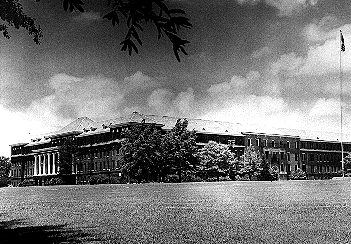
Old Main, originally called the Main Dormitory, was the first building on the campus of Mississippi State University.[24] The first section of Old Main was built in 1880. Additions were constructed in 1901, 1903, 1906, and 1922. It is considered to have been the largest college dormitory in the United States. The building was completely destroyed by fire on the night of January 22, 1959. The blaze claimed the life of Henry Williamson, one of the dorm's 1,100 residents. Bricks salvaged from the fire were used to build the Chapel of Memories.[25] Bricks from Old Main were also dumped in the area that became the band practice field for many years behind the Industrial Educational Building.

Roy Vernon Scott, professor emeritus of history at MSU is the author of Old Main: Memories of a Legend.[26]
Student organizations
The national literary magazine Jabberwock Review is also based at MSU.
Student media
Mississippi State's local radio station is WMSV.
Prior to WMSV, Mississippi State had a student-run radio station, WMSB which went off the air permanently at the end of the spring semester of 1986. WMSB was a low-power FM station with studios on the top floor of Lee Hall. WMSB was started the Fall Semester 1971 in a freshman dorm room on the third floor of Critz Hall utilizing a FM stereo transmitter that was designed and built as a high school science fair project by one of the station's founders. The station's original call letters were RHOM. Later, funding was solicited from the Student Association. Funding was approved, the low-power RCA FM transmitter was ordered and the call letters WMSB were issued by the FCC. The station was moved to studios on the top floor of Lee Hall that were formerly occupied by a student-run AM station.
The student newspaper is the Reflector, published twice per week on Tuesday and Friday. The publication was named the #1 college newspaper in the South in 2007 by the Southeast Journalism Conference. In previous years, The Reflector has consistently ranked in the top 10 among college newspapers in the southern United States.
Music scene
Mississippi State, and the city of Starkville play host the annual "Bulldog Bash", considered the largest outdoor concert in the state of Mississippi. Bulldog Bash is free and held in the Starkville Cotton District.
Mississippi State is home to WMSV, the campus radio station, which routinely plays older alternative mainstream rock and pop from the 1990s. Much of the music on the radio station comes from syndicated radio programs from Public Radio International, yet the station's homegrown music programs on Sunday afternoons and evenings emphasize jazz and blues classics.
During the spring semester the Old Main Music Festival takes place, it is also free to the public, and is held on the Mississippi State Campus it has featured artist such as Trey Songz, Sugarland and OneRepublic.[27]
The city of Starkville and the Mississippi State campus have been a tour stop for many artists such as 2 chainz, Bon Jovi, Elvis Presley, Bob Dylan[28] and most famously for Johnny Cash in 1965. After Johnny Cash's performance he was arrested, which led him to write the song "Starkville City Jail".[29]
Lecture series
Every semester Mississippi State has several distinguished speakers; these have included best selling authors Greg Mortenson[30] and Mississippi State alumnus John Grisham,[31] former United States Secretary of State Condoleezza Rice, Academy Award nominated Spike Lee,[32] television science show hosts Jeff Lieberman[33] and Dr. Neil deGrasse Tyson.[34] Also several Nobel laureates such as Sir Harry Kroto (1996 Nobel Prize in Chemistry),[35] J. M. G. Le Clézio ( 2008 Nobel Prize in Literature)[36] and Joseph Stiglitz ( 2001 Nobel Memorial Prize in Economic Sciences).[37]
SECU: SEC Academic Initiative
Mississippi State University is a member of the SEC Academic Consortium. Now renamed the SECU, the initiative was a collaborative endeavor designed to promote research, scholarship and achievement amongst the member universities in the Southeastern conference. The SECU formed its mission to serve as a means to bolster collaborative academic endeavors of Southeastern Conference universities. Its goals include highlighting the endeavors and achievements of SEC faculty, students and its universities and advancing the academic reputation of SEC universities.[38][39]
In 2013, Mississippi State University participated in the SEC Symposium in Atlanta, Georgia which was organized and led by the University of Georgia and the UGA Bioenergy Systems Research Institute. The topic of the Symposium was titled, the "Impact of the Southeast in the World's Renewable Energy Future."[40]
Greek life
Mississippi State's Greek system comprises 19 fraternities (IFC and NPHC) and 13 sororities (Panhellenic and NPHC). Fraternities and sororities take part in a number of philanthropic programs and provide social opportunities for students. Formal rush takes place at the start of every fall semester for Panhellenic and IFC organizations. Membership intake for NPHC organizations occurs at specified times.
Greek affiliation is popular at Mississippi State University. Approximately 20% of the student population participates in the Greek system.
IFC fraternities
Other fraternities |
Panhellenic sororities
Other sororitiesNational Pan–Hellenic Organizations |
Athletics
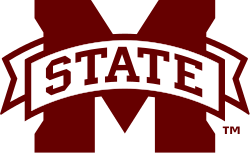

Mississippi State University's sixteen athletic teams are known as the Bulldogs, which was adopted in 1961. Previous nicknames included the Aggies and the Maroons. Since 1935, the official mascot for Mississippi State has been a live English Bulldog named Bully. They compete in Division I of the NCAA and the western division of the 14-member Southeastern Conference (SEC). The Bulldogs have garnered a total of 28 conference championships (14 SEC). Mississippi State's most successful sport is baseball. The Diamond Dogs have won 17 conference championships (11 SEC) and 6 SEC tournament championships, while making 28 NCAA Tournament, and 9 College World Series appearances, including a 2nd-place finish in 2013. The Diamond Dogs play home games at Dudy Noble Field, Polk-DeMent Stadium, which holds the NCAA record for the largest single on-campus baseball attendance at 15,586 (April 12, 2014, vs. Mississippi).
Mississippi State men's basketball has won 10 conference regular season championships (6 SEC), 4 conference tournament championships, and 7 divisional championships. The Bulldogs have made 10 NCAA Tournament appearances, highlighted by 3 Sweet Sixteen appearances and a trip to the Final Four in 1996. Both MSU men's and women's basketball teams play home games at Humphrey Coliseum, nicknamed "The Hump", one of the most intimidating places to play in the SEC with a seating capacity of 10,500.
Bulldog football is also a favorite among the MSU faithful. The Bulldogs play their home games at Davis Wade Stadium, the second oldest Division I-FBS football stadium in the nation, with a seating capacity of 61,337. Bulldog fans are known throughout the nation for bringing cowbells to "ring" Mississippi State on to victory. Cowbells became part of Mississippi State tradition in the 1970s, and were banned by the SEC in 1977, defined as "artificial noisemakers". For over 30 years, fans would secretly sneak their cowbells into the stadium, while security guards carefully "inspected" fans' possessions, continuing the unique tradition. In 2010, the SEC officially lifted the ban on artificial noisemakers, allowing fans to "ring responsibly" during pregame, timeouts, halftime, and Bulldog touchdowns. Mississippi State's first SEC championship came in 1941, as the Bulldogs finished with an 8-1-1 record. The Bulldogs also appeared in the 1998 SEC Championship Game after winning the SEC Western Division championship, before falling to eventual national champion Tennessee 14-24. Overall, MSU has appeared in 17 postseason bowl games, highlighted by trips to the Orange Bowl in 1937, 1941, and 2015. The official fight song and battle cry of Mississippi State is Hail State, which is played by the Famous Maroon Band, the university's marching band.
Accolades
| University rankings | |
|---|---|
| National | |
| Forbes[42] | 279 |
| U.S. News & World Report[43] | 157 |
| Washington Monthly[44] | 77[45] |
- Mississippi State was ranked the 36th top college in the United States by the Social Mobility Index college rankings.[46]
- Mississippi State University was ranked #18 nationally in Forbes magazine's "America's Best College Buys". In 2013, Forbes also ranked Mississippi State University #279.
- The university has produced 16 Truman Scholars and is one of 38 universities recognized by the Truman Foundation as an honor institution. The competitive Truman Scholarships are awarded to those who plan a career in public service. (2003)
- Mississippi State has had eight Barry M. Goldwater Scholars since 1999. The national scholarship recognizes academic excellence in the sciences, mathematics and engineering. (2003)
- Mississippi State has also produced George Mitchell, Ronald Reagan, and Morris Udall Scholars.
- Mississippi State ranks among the top 15 in the nation in awarding bachelor's degrees in both engineering and education to African-Americans, according to Diverse Issues in Higher Education.
- A 2007 NSF report on academic research and development ranked Mississippi State's engineering program 34th and agricultural sciences program 5th among all U.S. colleges and universities in R&D expenditures.[47]
- Mississippi State is among the nation's 100 "Baccalaureate Bargains" for 2002, according to Kiplinger's Personal Finance magazine. (2003)
- The Raspet Flight Research Laboratory at MSU was recognized as a National Landmark of Soaring in 2003[48]
- The Cullis & Gladys Wade Clock Museum, located at the MSU Welcome Center, features an extensive array of clocks and watches dating as far back as the early 18th century, and is the only collection of its size in the region.
- In 2009, MSU's School of Landscape Architecture was ranked the second best program in the nation by the journal DesignIntelligence in its annual "America's Best Architecture & Design Schools" rankings. The journal gave the program high marks in teaching students skills related to construction methods and materials. The University's School of Landscape Architecture program is the only such program in Mississippi.[49]
- PayScale.com listed a median starting salary of $44,200 and a median mid-career salary of $80,600 for Mississippi State baccalaureates.
Graduate
U.S. News & World Report National Rankings'[50]
| Graduate Area | 2012 National Rank |
|---|---|
| Engineering | 84 |
| Veterinary Medicine | 24 |
Notable alumni and faculty
- Notable people

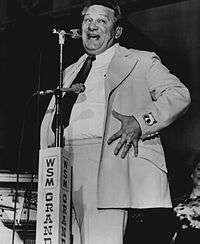


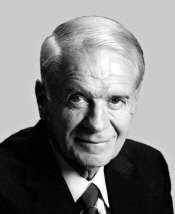
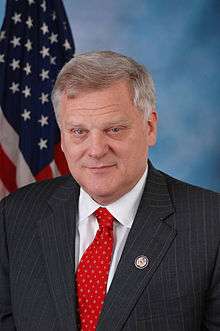 Alan Nunnelee
Alan Nunnelee
Representative of Mississippi's 1st congressional district January 3, 2011 – February 6, 2015
 Jonathan Papelbon
Jonathan Papelbon
One of 26 MLB closers to record 300 saves; currently plays for the Washington Nationals.

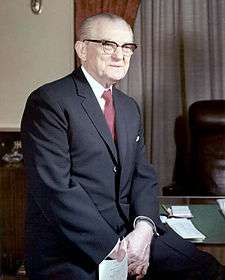

See also
- List of agricultural universities and colleges
- List of architecture schools
- List of business schools in the United States
- List of engineering schools
- List of forestry universities and colleges
- List of land-grant universities
- List of schools of landscape architecture
- List of research universities in the United States
- List of schools of veterinary medicine
References
- ↑
- ↑ "Faculty Report" (PDF). Mississippi State Office of Institutional Research. Retrieved July 19, 2009.
- ↑ http://www.msstate.edu/newsroom/article/2016/09/msu-announces-record-enrollment-welcomes-largest-freshman-class/
- ↑ "Mississippi State University History". State of Mississippi. Retrieved 2016-07-12.
- ↑ "Visual Identity Standards (Mississippi State University)". Msstate.edu. Retrieved 2014-08-14.
- ↑ "Mississippi State University Sponsored Programs Administration Web Page". Retrieved November 29, 2011.
- ↑ "City of Starkville Street Map". City of Starkville. Retrieved March 28, 2016.
- ↑ "Campus Map." Mississippi State University. Retrieved on March 1, 2011.
- ↑ "MSU hits 'very high research activity' benchmark (Mississippi State University)". Msstate.edu. 2011-01-26. Retrieved 2014-08-14.
- ↑ Salter, Sid (15 July 2015). "Mississippi State's First Black Student Showed Courage". Jackson Clarion-Ledger. Retrieved 28 October 2015.
- ↑ MSU News: Generous donation by alumnus funds honors college
- ↑ "MSU/SJSU Engineering Ph.D. Gateway Program". http://www.engr.sjsu.edu. SJSU Engineering. Retrieved 2016-09-08. External link in
|website=(help) - ↑ "'State of the Future' campaign ends successful run (Mississippi State University)". Msstate.edu. Retrieved 2014-08-14.
- ↑ Accessed February 13, 2008.
- ↑ "Library Location". Mississippi State University. 2011. Retrieved 2012-08-17.
- ↑ "Library Collection". Mississippi State University. 2011. Retrieved 2012-08-17.
- ↑ "Ulysses S. Grant's Presidential Library". Mississippi State University. 2011. Retrieved 2012-08-17.
- ↑ Smith (May 18, 2012), "Ulysses S. Grant: How 'bout them Dawgs!," The Dispatch
- ↑ "The Congressional and Political Research Center". Mississippi State University. 2011. Retrieved 2012-08-17.
- ↑ "Grisham Collection". Mississippi State University. 2011. Retrieved 2012-08-17.
- ↑ "Grisham Collection". Mississippi State University. 2011. Retrieved 2012-08-17.
- ↑ "Ragtime Jazz Festival". Mississippi State University. 2011. Retrieved 2012-08-17.
- ↑ "State Snapshot (Mississippi State University)". Msstate.edu. 2009-12-07. Retrieved 2014-08-14.
- ↑ http://www.msstate.edu/web/maps/index.php?building=UR032
- ↑ http://www.msstate.edu/web/maps/index.php?building=0099
- ↑ "Old Main: Memories of a Legend". library.thing.com. Retrieved July 20, 2010.
- ↑ "Old Main". Mississippi State University. 2011. Retrieved 2011-01-14.
- ↑ "Artists". Mississippi State University. 2011. Retrieved 2011-01-14.
- ↑ "Johnny Cash". msnbc. 2011. Retrieved 2011-01-14.
- ↑ "Greg Mortenson". 2011. Retrieved 2011-01-13.
- ↑ "John Grisham". 2011. Retrieved 2011-01-13.
- ↑ "Spike Lee" (PDF). 2011. Retrieved 2011-01-13.
- ↑ "Jeff Lieberman". 2011. Retrieved 2011-01-13.
- ↑ "Neil deGrasse Tyson". 2011. Retrieved 2011-01-13.
- ↑ "Sir Harold Kroto - 1996 Nobel Laureate in Chemistry". 2011. Retrieved 2011-01-13.
- ↑ "J. M. G. Le Clézio Nobel Laureate". 2011. Retrieved 2011-01-13.
- ↑ "Joseph Stiglitz Nobel Laureate". 2011. Retrieved 2011-01-13.
- ↑ "SECU". SEC. Retrieved 13 February 2013.
- ↑ "SECU: The Academic Initiative of the SEC". SEC Digital Network. Retrieved 13 February 2013.
- ↑ "SEC Symposium to address role of Southeast in renewable energy". University of Georgia. Retrieved 13 February 2013.
- ↑ http://www.gammabetaphi.org/
- ↑ "America's Top Colleges". Forbes. July 5, 2016.
- ↑ "Best Colleges 2017: National Universities Rankings". U.S. News & World Report. September 12, 2016.
- ↑ "2016 Rankings - National Universities". Washington Monthly. Retrieved September 6, 2016.
- ↑ "2014 National Universities Rankings". Washington Monthly. n.d. Retrieved May 25, 2015.
- ↑ "Social Mobility Index". Social Mobility Index. CollegeNet and PayScale. 2014. Retrieved June 5, 2015.
- ↑ Academic Research and Development Expenditures: Fiscal Year 2007. National Science Foundation
- ↑ "MSU flight research lab dedicated as national soaring landmark". Mississippi State University. November 4, 2003. Retrieved October 8, 2008.
- ↑ "MSU landscape architecture program gets very high rank". Mississippi State University. May 13, 2009. Retrieved June 3, 2009.
- ↑ "Mississippi State University Rankings". Colleges.usnews.rankingsandreviews.com. 2011-09-13. Retrieved 2011-09-13.
External links
| Wikisource has the text of a 1920 Encyclopedia Americana article about Mississippi State University. |
- Official website
- Mississippi State Athletics website
-
 "Mississippi Agricultural and Mechanical College". Collier's New Encyclopedia. 1921.
"Mississippi Agricultural and Mechanical College". Collier's New Encyclopedia. 1921.
